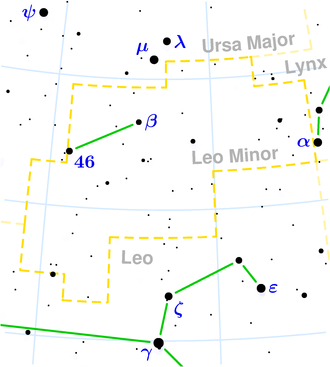NGC 2859
| Galaxy NGC 2859 |
|
|---|---|

|
|
| SDSS recording | |
| AladinLite | |
| Constellation | Little lion |
|
Position equinox : J2000.0 , epoch : J2000.0 |
|
| Right ascension | 09 h 24 m 18.5 s |
| declination | + 34 ° 30 ′ 49 ″ |
| Appearance | |
| Morphological type | (R) SB (r) 0+ / Sy |
| Brightness (visual) | 10.9 likes |
| Brightness (B-band) | 11.8 mag |
| Angular expansion | 4.6 ′ × 4.1 ′ |
| Position angle | 85 ° |
| Surface brightness | 13.9 mag / arcmin² |
| Physical data | |
| Affiliation | NGC 2859 group |
| Redshift | 0.005637 ± 0.000017 |
| Radial velocity | 1690 ± 5 km / s |
|
Stroke distance v rad / H 0 |
(74 ± 5) · 10 6 ly (22.7 ± 1.6) Mpc |
| history | |
| discovery | Wilhelm Herschel |
| Discovery date | March 28, 1786 |
| Catalog names | |
| NGC 2859 • UGC 5001 • PGC 26649 • CGCG 181-040 • MCG + 06-21-030 • IRAS F09212 + 3443 • 2MASX J09241854 + 3430481 • GC 1837 • H I 137 • h 593 • NSA 135879 | |
NGC 2859 is a lenticular galaxy with an active nucleus of the Hubble type SB0 / a in the constellation Little Lion in the northern sky . It is estimated to be 74 million light years from the Milky Way and about 100,000 light years in diameter. Together with NGC 2778 , NGC 2779 , NGC 2780 , NGC 2793 , it forms the NGC 2859 group .
The object was discovered by William Herschel on March 28, 1786 .
Web links
Commons : NGC 2859 - collection of images, videos, and audio files
